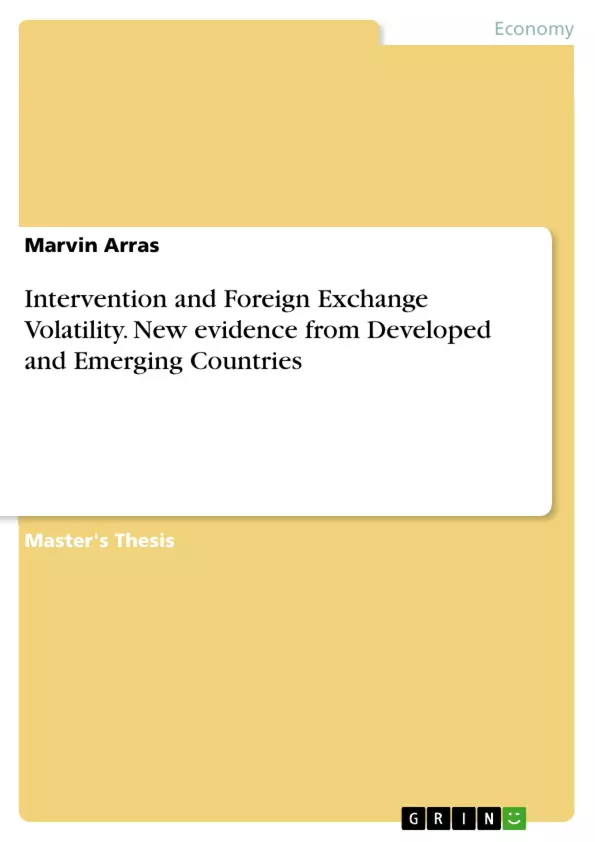This research explores the impact of foreign exchange rate interventions on the behaviour of exchange rate returns and their volatility. In 2017, monetary interventions are actual as they have never been before. However, they have been criticised for not being effective and existing empirical evidence is mixed. The present research applies models from the Garch framework, while using monthly data from 2001 to 2017 on the Usdeur, Gbpreur, Jpyeur and Inreur rate.
The results indicate that monetary interventions have a higher impact on developed country currencies than on emerging markets currencies. In addition, evidence is found that the volatility increased after the financial crisis.
Inhaltsverzeichnis (Table of Contents)
- Introduction
- Literature Review
- Data
- Data Description
- Volatility Clustering
- Multiple Breakpoint - Bai - Perron test
- Test for stationarity - Unit Root
- Correlogram
- Descriptive Statistics
- Methodology
- ARCH
- GARCH(1,1)
- GJR GARCH(1,1)
- Exponential GARCH(1,1)
- Integrated GARCH(1,1)
- Volatility Forecasting
- Empirical Results
- Results of the ARCH Effects testing
- Results of the GARCH(1,1) model
- Results of the GJR GARCH(1,1) model
- Results of the Exponential GARCH(1,1) model
- Results of the Integrated GARCH(1,1) model
- Results of Volatility Forecasting
Zielsetzung und Themenschwerpunkte (Objectives and Key Themes)
This research examines the influence of foreign exchange rate interventions on exchange rate returns and their volatility. The study focuses on the effectiveness of these interventions, particularly in light of their increasing use and mixed empirical evidence. Using monthly data from 2001 to 2017 on the USDEUR, GBPREUR, JPYEUR and INREUR exchange rates, the research employs models from the GARCH framework to analyze the impact of monetary interventions on exchange rate behavior.
- Impact of Foreign Exchange Rate Interventions
- Exchange Rate Return Behavior
- Exchange Rate Volatility
- Effectiveness of Monetary Interventions
- Comparison of Developed and Emerging Markets
Zusammenfassung der Kapitel (Chapter Summaries)
- Introduction: This chapter provides an overview of the research topic, highlighting the growing use of foreign exchange interventions and the mixed empirical evidence regarding their effectiveness. The research questions and objectives are outlined.
- Literature Review: This chapter reviews existing literature on foreign exchange interventions, their impact on exchange rate behavior, and the methods employed in previous studies. It explores different theoretical perspectives and empirical findings, providing a context for the current research.
- Data: This chapter describes the data used in the study, including the source, time period, and currency pairs analyzed. It also explains the methods used to analyze the data, such as volatility clustering, multiple breakpoint tests, unit root tests, and descriptive statistics.
- Methodology: This chapter details the statistical models used in the study, specifically various GARCH models: ARCH, GARCH(1,1), GJR GARCH(1,1), Exponential GARCH(1,1), and Integrated GARCH(1,1). It also discusses the process of volatility forecasting.
- Empirical Results: This chapter presents the findings of the analysis, including the results of the different GARCH model estimations and the volatility forecasting outcomes. It examines the impact of monetary interventions on exchange rate returns and volatility, comparing the findings for developed and emerging market currencies.
Schlüsselwörter (Keywords)
This research centers around the following key concepts: foreign exchange interventions, exchange rate returns, exchange rate volatility, GARCH models, monetary policy, developed markets, emerging markets, and financial crisis. The research employs empirical analysis to explore the relationship between these concepts and their implications for exchange rate behavior.
- Quote paper
- Marvin Arras (Author), 2017, Intervention and Foreign Exchange Volatility. New evidence from Developed and Emerging Countries, Munich, GRIN Verlag, https://www.grin.com/document/387544



